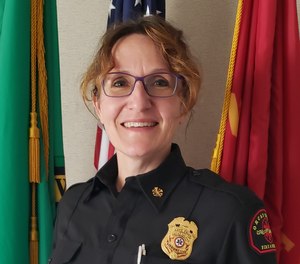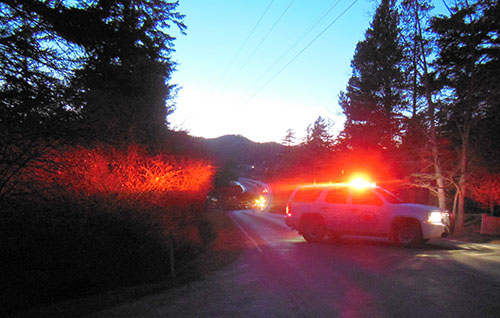Setting the tone and driving organizational change from the chief’s seat
||| FROM EMS1.COM |||
The spark: What put you on the path to becoming a Chief?

Holly vanSchaick, fire chief of Orcas Island Fire & Rescue in Eastsound, Washington. (Photo/Courtesy of Holly vanSchaick)
I came to the fire service for a love of the work and the team environment. At its best, the fire service unites a diverse group of individuals around one common goal – helping someone on their worst day. Early in my career, it did not occur to me to ever want to leave the line and move to admin.
As I transitioned from volunteer to career, I had a variety of experiences with fire chiefs I worked for; some positive and some negative. As I grew up as a first responder, it became apparent to me that positive cultural change can’t happen effectively when it is only being driven from the bottom up. An organization’s leadership sets the tone for what the culture of the team will be.
Back when I was training for a few different running events, I had a coach who would say, “You can’t outrun a bad diet.” In the context of my work environment, I turned that into, “You can’t outwork bad leadership.” I realized that in order to help bring about the cultural development the fire service was in need of, I would need to be willing to put myself in the arena in a leadership role. Two of the best chief officers I had the honor to serve under encouraged me to enroll in a Fire Service Administration degree program. I did so and earned a BS in Fire Service Administration from Eastern Oregon University.
Look ahead: What’s something you want to accomplish in your first year as Chief?
In my first year as chief, my goal is to continue to build on the positive groundwork we have laid in the last two years at OIFR. When I joined OIFR as assistant chief in 2021, it was amidst significant turmoil between labor and management, and between career and volunteer staff. Volunteers rarely just dropped by our headquarters station. Many told me they avoided it altogether because it felt like a dark cloud was hanging over it.
Fast forward to today, and some days I have trouble finishing a project I am working on because volunteers and career staff pop into my office so frequently. As far as I am concerned, this is the best “problem” a chief officer could have, and one I will strive to keep! Our department is now united, labor and management have the best relationship I have ever seen (including during my own time as a union officer), and volunteers have told me time and time again how much they now enjoy working with the career staff. My goal in the next year is to continue to foster these strong relationships, while also looking forward to the significant impending apparatus needs of our aging fleet.
How will you create an organizational culture that people want to be a part of, to join, and to stay in?
Again, as discussed above, I think we have mostly gotten there today in terms of creating an organizational culture people want to be a part of. Now, we have to be committed to keeping it going. In 2022, our department participated in a culture and values workshop with Rob Nielson of All American Leadership. This was an important endeavor for a few reasons. First, it helped refocus and unite our team on our purpose – that thing that is the foundation of our relationship, the reason we are here, together. Second, it provided (and still provides through ongoing surveys) feedback regarding what those of us in leadership positions are doing right, and what we still need more work on. Building on the positive while not ignoring the negative is essential to ongoing cultural maintenance.
How are. you going to support and stand up for your personnel, internally and externally, to show that you can about them as a person and a professional?
Our relationships need to be built on trust. Trust is mutual. As their chief, it is my job to extend my trust to my personnel, before asking them to trust me in return. This doesn’t mean that everything is perfect; extending trust means that I know their intentions and purpose in their work. Every conversation I have with those who report directly to me has to start with that premise. I trust why they are doing things. Then, when we sometimes have to discuss how we get our common goals accomplished, we are doing so from a collaborative, trusting team approach. When we have a good pattern of communication and trust, it is easy for me to stand up for them if needed.
As far as showing them that I care about them as a person? It’s a two-step process:
- Step 1. Caring about them, authentically. This is easy. I currently work with the best team I have encountered in my entire career. I wouldn’t know how to NOT care about them.
- Step 2. Making sure I take the time to let them know that I care.
How do you demonstrate servant leadership?
My job is to serve the members of my department so that they can go out and do their best work to serve the public. This isn’t accomplished in any one action. I may cook them dinner, or take out the trash, or roll hose with them after a fire or training, but if my heart and mind aren’t in the right place, that will be obvious. Servant leadership starts from within, from constantly refocusing my own mind on acts of service toward the members of the department that I am responsible to. One of my favorite quotes is from political satirist and Journalist, P.J. O’Rourke; “Everyone wants to save the earth; but no one wants to help mom do the dishes.” I remind myself that “doing the dishes” is as much a part of my job as anyone else’s.
Leadership lightning round
- What is a leadership book, podcast or seminar you’ve found invaluable? The FBI-LEEDA Command Leadership Institute taught by Anne Kirkpatrick, was the best leadership course I have ever taken.
- If you knew the budget request would be approved, what’s a big purchase you’d make for your department today? I would hire a full-time division chief of training to allow more frequent onboarding of volunteers, as well as increase training opportunities for career and volunteer staff to train together.
- How do you recharge/improve your resiliency? I recharge with time spent in nature, or with my friends and family, and by working out. I also work on triaging issues into “area of concern” and “area of control.” There are so many ways to spend my time in my direct “area of control,” it is a good reminder that I have to prioritize my own energy in ways I can be effective.
**If you are reading theOrcasonian for free, thank your fellow islanders. If you would like to support theOrcasonian CLICK HERE to set your modestly-priced, voluntary subscription. Otherwise, no worries; we’re happy to share with you.**









Thanks for publishing this interview, but who or what is EMS1.com?
I like the part about “…doing the dishes”, as well as focusing on building the local volunteer and local career training programs.
Jean, you should be able to click on the above link: FROM EMS1.COM. They know much more about themselves than I would.
There is much I want to say about this interview, and so much to call out what is said by our new appointed chief, point by point. There are so many contradictions and red flags; maybe that is why there is no comment. People are either afraid of being sued by sore losers, or gobsmacked into silence.
This, and the steps this current board of commissioners is making and has made, have given more reasons than ever for a ‘vote of no confidence’ in this appointed fire chief and the reckless spending – the fallout of which will land in the laps of the incoming board. This only goes to prove WHY the same-old-same proposed permanent levy being pushed on us should be shot down, as what they are doing is nothing short of extortion of the tax base of this district while holding the last two Orcas resident career EMTs hostage to force a vote for the levy.
Please don’t fall for this despicable approach to their budget woes, when the last thing mentioned in steps going forward is replacing dangerously outdated and failing fire trucks. Such hypocrisy.
All the training in the world won’t buy badly needed fire engines and safety equipment for our first line responders. You can quote me on that.
I hope the levy fails by an even greater “vote of no confidence” than in the primary. If I were a lawyer, I would be taking on a class action suit against these actions, pro bono – for as long as it took to straighten out this mess.
The word, ‘culture’ has been co-opted by corporate Human Resources doublespeak. There used to be an actual culture in what it means to be a first responder. THIS… is not it!
I hope people can, and will, take the time and effort to read between the lines of what is written here and contrast slick good-sounding doublespeak with the realities of the actions still being perpetrated today. I question the legality of many of the actions.
There is no question regarding the unethical nature of what’s been done and is being done – failing grade, and vote of no confidence.
Sadie, your comments are spot on!!! I think it ties to a question that Toby and others asked at the “Town Hall”. Paraphrased, “What issue(s) does the community have with OIFR that is keeping them from voting in favor of the critical levy?”. One word covers it all. TRUST. The community does NOT TRUST the commissioners and chief. Period. Why? Their actions are frequently not transparent. People do not trust others who do things not open to the public or public discussion and input. The community is provided only with their action, after they have already taken them. Most recently it is the collective bargaining agreement (CBA) with the union. They approved it without any public visibility on the cost or other terms. It is not confidential, it is a public document. Sadie, along with voting down the levy it is also critical to vote out the commissioners running for re-election and create a new board we can TRUST. Unfortunately, only 3 of the seats are opposed. But the good news is that is enough for a majority, one that can rebuild the public trust. Once they do, the money will flow.